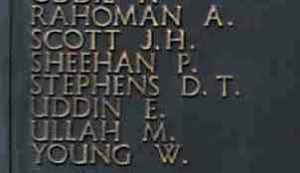The town of Cilgerran is sat alongside the River Teifi, on the northern edge of Pembrokeshire, bordering Ceredigion to the north. It is the home of Cilgerran Castle, an impressively sited Norman stronghold, which was built around 1100AD. At the gates to the castle are sited both of the towns War Memorials, commemorating the men of the locality who died in both World Wars of the Twentieth Century. Many thanks are due to Heather Tomos for the photographs of the memorial from where the transcriptions are taken, and for the help and additional information on the men, including some of the newspaper clippings.
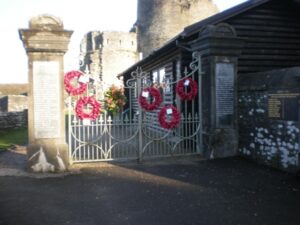
The Great War, 1914-1918
David Beynon, Sapper, 201644, Royal Engineers. David was born in Ferryside, Carmarthenshire, and later moved with his elder brother to live at Cilgerran, where the two boys worked with their Uncle as Coopers. Here, David met and married his wife Esther Mary Beynon (nee Williams), and the young couple set up home at Castle Square, where they had two children together. Little is known of David’s service, but he joined the Royal Engineers, serving with the rank of Sapper throughout his time at war. Sadly, David became one of many men to suffer due to his military service, dying just 18 months after the Armistice on 9 June 1920. He was by then 36 years old, and left his widow and two children behind. David is buried at Cilgerran Churchyard.
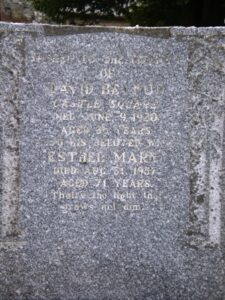
Lawrence Robert Vaughan Colby, Major, Grenadier Guards. Lawrence was born on 3 April 1880, the only son of John Vaughan Colby, of Ffynone, Pembrokeshire, and Anne Harriet Colby. Lawrence was a pre-war regular in the Army, and at the outbreak of war served as a Major with the 1st Battalion, Grenadier Guards, attached to 20 Brigade, 7th Division. The Division was formed during September, 1914 and landed at Zeebrugge on 6 October, 1914. The City was already falling however, and so the Division was moved to Ypres, where they became the first British Division to hold the city. They fought during the First Battle of Ypres, and helped stop the German advance through Belgium. Lawrence was sadly killed in action at Ypres on 24 October, 1914. He was 34 years old, and has no known grave, and so is remembered on the Ypres (Menin Gate) Memorial, Belgium.
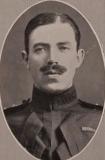
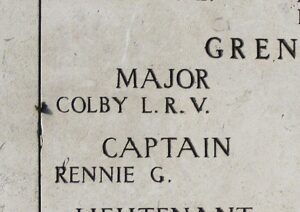
David Davies, Private, 10227, Canadian Mounted Rifles. David was born on 31 May 1882, the son of Thomas and Esther Davies, of Llwyncelyn, Cilgerran. He had emigrated to Canada prior to the war, where he found work as a Carpenter. On 20 July 1915 David enlisted at Sewell, Manitoba into the Canadian Infantry, giving his next of kin as his sister, Mrs Esther Griffiths, who was residing at Heolas, Ammanford. David was posted to the Canadian Mounted Rifles, but was sadly killed while training on 10 August 1915. He was 33 years old, and is buried at Broadview Cemetery, Saskatchewan, Canada.
John Morris Davies, Sapper, 452460, Royal Engineers. John was born in 1878, the son of David Davies and Anne Davies (nee Jones), of Cilgerran. By 1902 he was residing at Monmouth, and during the Spring of that year married Maud Ella Blanche Williams. The couple set up home at 89, Monument Street, Monmouth and John worked in the town as a Post Office Clerk and Telegraphist. He enlisted into the Royal Engineers at Cardiff on 6 July 1915 and was posted to the 68th (2nd Welsh) Division Signals Company, Royal Engineers at Bedford. As a trained telegraphist, his skills were soon needed elsewhere, so on 28 September 1917 John embarked at Devonport aboard the SS Honorata and sailed for Durban, where he trans-shipped aboard the SS Caronia for Kilwa, in German East Africa (now Tanzania). On 13 November he was posted to the Imperial Signal Company. John served in East Africa for several weeks before contracting dysentery and was sent to the Hospital at Massassi, a town some 100 miles from the coast. He died in hospital there of dysentery on 3 January 1918, aged 40. John was originally buried in Massassi Cemetery, but after the war the war graves within the cemetery were exhumed and re-interred in Mtama Cemetery, Tanganyika before being moved again to Dar Es Salaam War Cemetery, Tanzania.
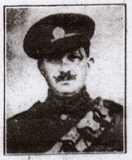
John Thomas Davies, First Mate, Mercantile Marine. John (who was known locally as Jack) was the son of David and Elizabeth Davies (nee Jones), of Minerva House, Cemas Street, Cilgerran. Jack followed the trade of his father, and served as First Mate in the Merchant Navy, aboard the SS Laurium, a London based defensively armed vessel. On 23 April 1918, she was 15 miles east from Skegness, when she struck a German mine and sunk with the loss of just one man. Unfortunately the dead man was Jack David. He was 22 years old, and is commemorated on the Tower Hill Memorial in London.
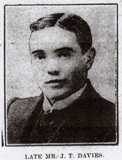
William Davies, Private, 202483, Welsh Regiment. William was born in London in 1891, the son of Robert Davies. He had come to Cilgerran to work at Forest Farm at some time prior to the war. William married Annie Hayes, the daughter of James and Margaret Hayes of 26, Front Street, Pembroke Dock, who was also working at Forest farm, on 5 October 1916, and the couple set up home at Revoir House, Cemaes Street, Cilgerran. William enlisted into the Welsh Regiment, and was posted to the 9th Battalion, Welsh Regiment. The battalion was involved in heavy fighting during the German offensive on the Somme on 21 March 1918, and suffered heavy casualties over the coming weeks. William was gassed and taken prisoner by the Germans around this time. He was released after the armistice and returned home, but after suffering from ill health for several years, died of tuberculosis at Aberystwyth on 20 September 1925, aged 34 years. Of those named on the village memorial, William was the last to die. He was buried with full military honours at St Llawddog’s Church, Cilgerran. He is not commemorated by the CWGC because his death was too late for official commemoration.
Angus John Charles Dodgshon, Lieutenant, Gloucestershire Regiment. Angus was born at Alltyrheiny, Cilgerran on 21 April 1895, the only son of John Julius and Ada Charlotte Dodgshon, later of Bream Lodge, Gloucester. After being educated at Hurst Court and at Wellington College, he entered Trinity College, Cambridge. Angus had a very keen interest in magic, and in 1913 joined the Magic Circle, where he became well known for his enthusiasm. However at the outbreak of war, Angus realised his duty, and joined the Officer Training Corps, from where he was gazetted as 2nd Lieutenant with the 2/5th Battalion of the Gloucester Regiment in October 1914. The battalion served on Home Service during the early part of the war, and moved to France on the 23 May 1916 as part of 184 Brigade, 61st Division. Angus remained in Britain for a while, where he was promoted Temporary Captain, and he himself moved to France on 31 August 1917. The division was by then at Ypres, taking part in the Third Battle of Ypres, and in late August and early September it was involved in the efforts to push the line forward at positions around Schuler Farm and Aisne Farm near Kerselaar. The Division then moved south, where it was to take part in the Battle of Cambrai. Angus was however killed here during the build up to the battle, on 10 November 1917. He was just 22 years old, and is buried at Sunken Road Cemetery, Fampoux. One of his fellow officers wrote a short letter of condolence to his parents soon after; ‘During his short time with us he became very dear to me, and always kept us jolly with his amusing tricks and happy-go-lucky ways. He was getting on so well in the Battalion, and all the men loved him…’
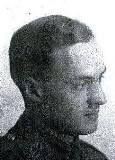
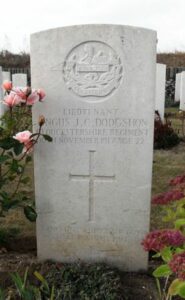
Arthur Edwards, Gunner, 100984, Royal Garrison Artillery. Arthur was the son of John and Martha Jane Edwards, of East Williamston, Tenby. For several years prior to the war, Arthur had worked as a Postman, covering the Llanboidy and Whitland area, before moving with his wife Ellen Ann Edwards, to Chapel House, Cilgerran. It is not known when he enlisted, but Arthur served with the 188th Siege Battery, Royal Garrison Artillery, which was in France by the 30 October 1916, as part of 53 Brigade RGA., attached to the First Army, and saw much heavy fighting for the remainder of its time at war. Arthur sadly died after the war, probably due to the influenza epidemic, on 17 November 1918. He was 33 years old, and is buried in Cambrai East Military Cemetery, France.
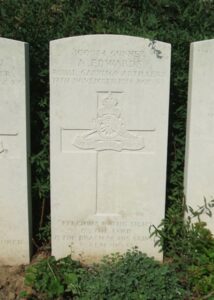
Arthur Owen Evans, Private, 6512, Australian Infantry. Arthur wwas born at Rhoshill in 1889, the son of John and Elizabeth Evans. He was educated at Bridell Council School. Arthur had emigrated to Australia aboard the SS Commonwealth in June 1911, and became a farmer at Spould’s Lagoon, Temora, New South Wales. On 10 July 1916 Arthur enlisted into the Australian Infantry at Victoria Barracks, Sydney and was posted to the 21st Reinforcements for the 13th Battalion, Australian Infantry. On 7 October 1916 Arthur embarked at Sydney with his unit aboard the SS Ceramic, bound for England, and disembarked on 21 November at Plymouth. After a period of training at Salisbury Plain, Arthur embarked at Folkestone on 8 February 1917, and on arrival in France joined the 13th Battalion, Australian Infantry, which was attached to the 4th Australian Brigade, 4th Australian Division. The Division was still on the Somme when Arthur arrived and followed the German withdrawal to the Hindenburg Line during March 1917. On 11 April 1917 the Division took part in the costly Battle of Bullecourt, before being moved north to positions south of Ypres and on 7 June 1917 took part in the great Battle of Messines Ridge, storming the German positions which had been devastated by the blowing of a chain of massive underground mines. The 13th Battalion was in reserve for the initial assault, then just before midnight moved forwards under cover of darkness into the new reserve line, before relieving the tired 1st New Zealand Brigade in the front line on 9 June. Arthur was killed at Messines near Midland Support Trench on 10 June 1917. The 27-year-old has no known grave, so is commemorated on the Ypres (Menin Gate) Memorial, Belgium.
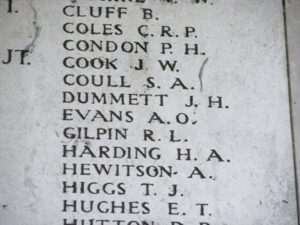
David Albert Evans, Private, 49014, Welsh Regiment. David was the son of Enoch and Letitia Evans, of Plain Dealings, Cilgerran. David had worked as a gardener in Ireland prior to the war, but returned home to enlist into the Army. He was posted to the training camp at Kinmel Park, near Rhyl, where he became a Private with the 3rd Battalion, Welsh Regiment, a training battalion, which supplied recruits to the Welsh battalions on the Western Front. David sadly became ill with pneumonia whilst at Rhyl, and died on 14 February 1917. His body was brought home for burial at Cilgerran, at St. Llawddog Churchyard. His coffin arrived at the Railway Station where it was draped with a Union Jack, and a large gathering of friends and family escorted him to the Churchyard. David had two brothers. One brother, James Samuel Evans was killed while serving with the Black Watch, another brother served in Salonika.
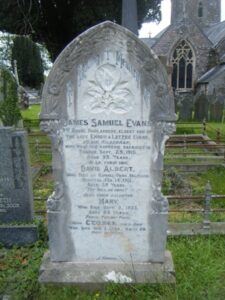
James Samuel Evans, Private, S/4980, Black Watch (Royal Highlanders). James was born at Cilgerran, the son of Enoch and Letitia Evans of Plain Dealings, Cilgerran and was the brother of David Albert Evans and of John Phillip Evans, of Argoed, Glanyrafon Road, Pencoed. Both James and John must have moved to the valleys to work in the mines, and it was there that they both enlisted into the Army, with James being posted to the 9th Battalion, Black Watch. John served with the British Salonika Forces. The 9th Battalion of the Black Watch formed part of 46 Brigade, 15th (Scottish) Division, which landed in France during July 1915. The division saw its first major action during the Battle of Loos, and sadly it was here that James was killed, during the first day of the battle, on 25 September 1915. His grave could not be located, and so he is commemorated on the Loos Memorial, France. In less than fifteen months his brother David was also dead, after catching pneumonia at Rhyl.
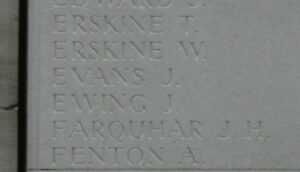
John Griffiths, Seaman, 1643C, Royal Naval Reserve. John was the son of Moses and Mary Griffiths, of Dolbadau, Cilgerran, and had served in the Royal Navy as a regular prior to the outbreak of the war, and had retired to join the Royal Naval Reserve. At the outbreak of war, John was recalled to the colours, and by 1917 was serving aboard HMS Princess, which was a modern Battlecruiser, launched in 1911. She had seen action during the Battle of Heligoland Bight and the Battle of Dogger Bank, and was damaged at the Battle of Jutland in 1916. John was taken ill while HMS Princess was off South Africa, and he died at Simon’s Town on 31 May 1917, where he was buried at Dido Valley Cemetery. He was 46 years old.
Charles Hudson MM, Sergeant, 40526, South Wales Borderers. Charles was born at Southampton in 1885, the son of William and Mary Hudson. He married Margaret Ann Parry, of Brynglas House, Cilgerran, on 9 March 1913. By the outbreak of war he was living at Cross Hands, and he enlisted at nearby Llanelli into the Welsh Regiment. At some time later Charles was transferred to the 2nd Battalion, South Wales Borderers, which was attached to 87 Brigade, 29th Division. The Division had moved to Gallipoli via Egypt, landing on 25 April 1915. They remained here until evacuation to Egypt on 11 January 1916 and then moved to the Western Front on 15 March. The Division took part in its first major action in France during the 1916 Somme Offensive, and fought at the Battles of Albert and Le Transloy, suffering heavy casualties, one of them being Charles who was badly wounded in the leg. He returned to action though, and in the spring of 1917 the division fought at the Battle of the Scarpe, which was part of the Arras Offensive, and then moved further north to Ypres. Here they fought at the Battle of Langemarck, and then at the Battles of the Menin Road, Polygon Wood, Broodseinde and Poelcappelle, before moving to Cambrai. Charles was awarded the Military Medal for bravery in the field for his gallantry during the fighting at Ypres, which was listed in the London Gazette of 16 November 1917, while his battalion was fighting in the Battle of Cambrai. The division returned to Flanders early in 1918, and was hit there by the German Spring Offensive, which saw them take part in the Battle of Estaires, which is where Charles was killed on 11 April 1918. He has no known grave, and is commemorated on the Ploegsteert Memorial, Belgium.
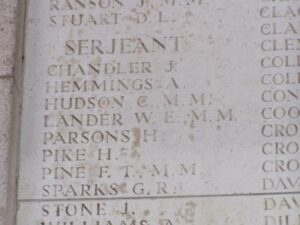
Edward Griffith James, Private, 202704, Welsh Regiment. Edward was born on 10 September 1886, the son of William and Georgina James, of High Street, Cilgerran. He travelled to Carmarthen to enlist into the 4th Battalion, Welsh Regiment. After his training, he was posted to the 9th Battalion, which formed part of 58 Brigade, 19th (Western) Division, which had been in France since July 1915. The Division had fought during the opening attack of the Battle of Loos, and then moved to the Somme, where they took part in the second wave of the attack on Ovillers-La Boiselle on 1 July 1916, capturing the village at heavy cost, and fought through the Somme Battles of Pozieres and the Ancre in 1916. They then moved north to Ypres, and took part in the Battle of Messines. The division then moved further north to Ypres itself, which is where Edward joined up with his battalion, and fought on the Menin Road and at Polygon Wood, before taking part in the fighting at Broodseinde, Poelcappelle and Passchendaele Village itself. After surviving the horrors of Passchendaele, Edward moved with the division to positions north of St. Quentin, which is where he was killed on 18 December 1917. He is buried at Fifteen Ravine British Cemetery, Villers-Plouich.
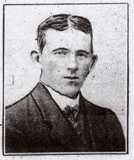
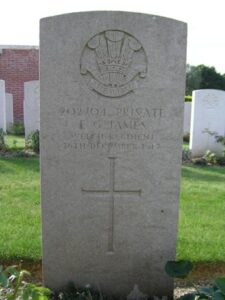
Martha Emily Jenkins, Stewardess, Mercantile Marine. Martha was born at Liverpool, the daughter of Joseph and Fanny Jenkins. Her father was from Cilgerran. She served as a Stewardess in the Mercantile Marine, and by 1915 was serving aboard the Liverpool registered SS Aguila. On 27 March 1915 Aquila was steaming off the Pembrokeshire coast, en-route from Liverpool to Lisbon, when she was attacked by the German submarine UB-28, which had surfaced and signalled to the steamer to stop. The captain of Aguila signalled to his engine-room for full speed to escape, but the submarine began shelling the ship and damaging it. The steamer stopped to lower its lifeboats, but the Germans maintained their fire on it, killing the boatswain, donkeyman, a lady passenger and Martha, and wounding several others. The survivors were later rescued and brought to the safety of Fishguard where their story was told. Martha was 42 years old when she was killed that day and is commemorated on the Tower Hill Memorial, London. She does not appear to be commemorated locally.
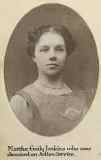
Thomas Griffith Jones, Private, 2150, Welsh Regiment. Thomas was born at Cardigan, and was the Husband of Frances Anne Jones of Cilgerran. The couple had a son, David Thomas Jones, who was later sadly killed during the Second World War. Thomas was one of many local men to enlist at Cardigan at the outbreak of war, into the local Territorial Battalion, the 1/4th Battalion, Welsh Regiment. The battalion moved to Tunbridge Wells in November 1914 as part of the South Wales Brigade, and in February 1915 moved to the Forth and Tay Defences in Scotland. In April they were posted to 159 Brigade, 53rd (Welsh) Division, which moved to the Mediterranean, sailing from Devonport in July, 1915 arriving at Mudros by 5 August, 1915. From here they moved to Gallipoli, landing on 9 August 1915. Here they immediately faced the chaos and impossible situation of the British that was to lead to the ultimate failure of the campaign, and spent the next few days in isolated pockets, fighting against a Turkish counter-attack during the Battle of Sari Bair. Thomas was one of many men to lose his life during these terrible first few days on the Gallipoli Peninsula. He was killed on 11 August 1915, and is commemorated on the Helles Memorial, Gallipoli.
William James Jones, Private, M/295967, Tank Corps. William was the son of Daniel and Margaret Jones, of Church Street, Cilgerran and enlisted at Fishguard into the Army Service Corps, most probably as a Motor Driver. William was then attached to the 8th Battalion of the Tank Corps, William was caught up in the heavy fighting that resulted from the German Spring Offensive on the Somme during March 1918, and was evacuated to No. 12 Stationary Hospital at St. Pol, where he died on 30 April 1918. William was just 20 years old, and is buried at St. Pol British Cemetery, St. Pol-Sur-Ternoise, near Arras in Northern France.
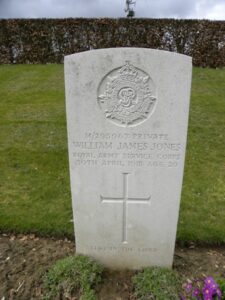
Simon Jones Lloyd, Private, 14226, King’s Shropshire Light Infantry. Simon was born in Cilgerran in 1892, the son of Thomas and Rhoda Esther Lloyd. Following the death of his mother in 1895 his father moved to 29, Seymour Street, Aberdare and remarried in 1905, while Simon was raised by his grandparents in Cardigan, joining his father in Aberdare by about 1911. He worked as a coal miner prior to enlisting at Merthyr into the 7th Battalion, King’s Shropshire Light Infantry, which was attached to 76 Brigade, 25th Division. He landed in France with the battalion on 28 September 1915 and on the following month the battalion joined the 3rd Division. Simon saw action with the division during the Actions of the Bluff and the St. Eloi Craters before it moved south to take part in the Somme offensive. During the following year the division fought at the Battle of Arras, Passchendaele and the Battle of Cambrai. Simon was wounded at some time and attached to the 25th Division Signals, Royal Engineers. He took ill towards the end of the war and died of pneumonia at 26 General Hospital, Étaples on 22 October 1918, aged 26. He is buried in Étaples Military Cemetery, France. Simon does not appear to be commemorated locally.
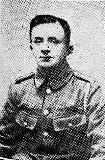
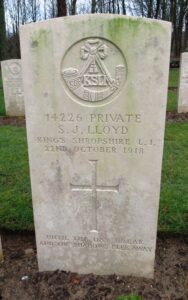
Thomas Milton Mason (‘Hammie’), Private, 23127, Royal Welsh Fusiliers. ‘Hammie’ was the son of Joseph and Annie Mason, of 86, Quarella Road, Bridgend. Thomas lived at Cilgerran prior to the war, but enlisted at London into the Army, joining the 9th Battalion, Royal Welsh Fusiliers, which was part of 58 Brigade, 19th (Western) Division. Thomas for some reason unknown to all but himself had enlisted at the outbreak of war and served under the alias of John Davies. The 19th Division moved to France in July 1915 and fought during the opening attack of the Battle of Loos, before being moved to the Somme, where they took part in the second wave of the attack on Ovillers-La Boiselle on 1 July 1916, capturing the village at heavy cost. They fought through the Somme Battles of Pozieres and the Ancre in 1916, before being moved to positions south of Ypres, and took part in the Battle of Messines. Hammie was killed in action at Messines on 7 June 1917. He was 31 years old, and is buried at Croonaert Chapel Cemetery, Belgium. His commanding officer wrote “Your son was a very brave soldier always cheerful and willing and very popular with officers and men. You have the sincere sympathy of everyone here in your sad bereavement. It may condole you to know that during his period as a stretcher bearer he saved many lives by his fearless conduct”.
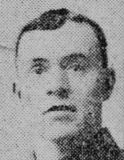
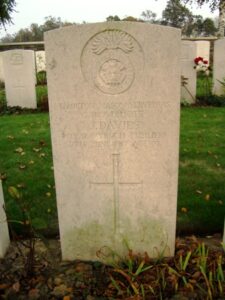
James Mathias, Private, 17169, Royal Welsh Fusiliers. James was born in Hoxton, London, but lived at Cilgerran prior to the war. He enlisted at Bridgend into the Army, joining the 13th Battalion, Royal Welsh Fusiliers, which was part of 113 Brigade, 38th (Welsh) Division. The division had moved to France in December 1915, and moved to positions near Fleurbaix to train. Almost six months later the division marched south to the Somme area, where they were allotted with capturing the heavily fortified Mametz Wood. The first attack went in on 7 July but was repulsed with heavy losses, so after a brief stoppage to rethink their strategy, the division attacked the wood again on 10 July 1916, again suffering terrible casualties. One of the dead of that second day was James. He is buried at Caterpillar Valley Cemetery, Longueval. James is not commemorated at Cilgerran.
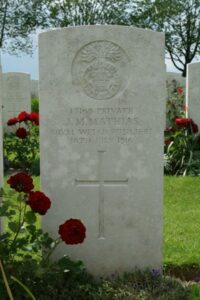
Arthur Owen Michael, Private, 74139, Notts & Derby (Sherwood Foresters). Arthur was the son of Thomas and Mary Ann Michael, of Castle View, Cilgerran, and enlisted at Carmarthen into the Army. He was posted to the 10th Battalion, Sherwood Foresters, part of 51 Brigade, 17th (Northern) Division. Between the 12 to 17 July 1915 the Division landed in France. They spent their initial period of trench familiarisation and then holding the front lines in the southern area of the Ypres salient. Here they took part in fighting at the Bluff during February, 1916 before moving south, where they fought at the Battle of Albert, where the Division captured Fricourt at heavy cost during the opening of the Somme Offensive. They then saw action during the Battle of Arras, at the First and Second Battles of the Scarpe and the Capture of Roeux, before moving back to Ypres, and taking part in the First and Second Battles of Passchendaele. In March, 1918 the Division were on the Somme, and faced the German Spring Offensive there, fighting at the Battle of St Quentin. Arthur was wounded on the first day of the offensive, and died on 22 April 1918. He was just 19 years old, and is buried at Varennes Military Cemetery, France.
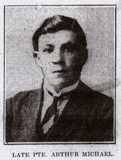
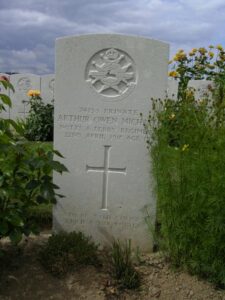
Thomas Aeron Morgan, Private, 27795, Welsh Regiment. Thomas was born at Rhydymul, Cilgerran, the son of Thomas and Catherine Morgan. The family later resided at Roadside, Blaenporth. Thomas resided in Ferndale prior to the war, where he had gained work as a coalminer. He enlisted at Cardiff into the 18th Battalion, Welsh Regiment early in 1915. The battalion was a Bantam battalion, made up of men below the minimum height requirements, which initially moved to Prees Heath in Shropshire, before joining 119 Brigade, 40th (Bantam) Division, and moved to France in June 1916, taking over positions near Loos. Late in 1916 the Division moved south to the Somme, and fought at the Battle of the Ancre, before remaining in the sector over the winter. In March 1917 the Germans withdrew to their shortened line, called the Hindenburg Line, and the 40th Division was among the units which followed the withdrawal. Later in the year the Division took part in the Battle of Cambrai and launched an attack on Bourlon Wood on 23 November 1917. The attack was carried out by 119 Brigade, led by the 12th SWB and 19th RWF. The 17th Welsh was in support for the initial assault, but was soon ordered to advance, to support the two attacking battalions. Heavy fighting raged within the wood over the coming days, with the 18th Welsh also being thrown forwards into the fight, and the Division suffered terribly. Thomas was killed in action in Bourlon Wood on 24 November 1917. The 20-year-old has no known grave and is commemorated on the Cambrai Memorial, Louverval, France.
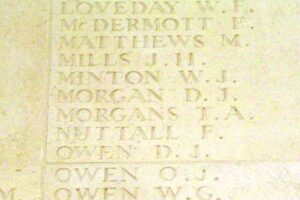
William David Morgan, Able Seaman, R/2410, Royal Naval Division. William was born on 8 October 1896, and had been adopted by his Aunt, Margaret Jenkins, of Brynderi Cilgerran. He enlisted into the Territorial Force on 1 March 1916, joining the 2/25th London Cyclist Battalion, then transferred to the Royal Naval Volunteer Reserve, and was posted to the Drake Battalion, 63rd (Royal Naval) Division, joining them in France on 2 September 1917. The division was at Ypres, where they were to take part in the assault on Passchendaele Village, and on 30 October the Drake Battalion supplied a party of 6 officers & 250 Other Ranks as Stretcher Bearers on account of 190 Brigade Operations at Passchendaele. The War Diary for the day states that Casualties that day amounted to three Other Ranks killed, eight Other Ranks wounded and one Other Rank missing. One of the wounded was William, who had received multiple wounds to his legs, with one leg being fractured. He was admitted that same day to 47th Casualty Clearing Station near Poperinghe, where he sadly died of his wounds on the following day of 31 October 1917. William was just 21 years old, and is buried at Dozinghem Military Cemetery, Belgium.
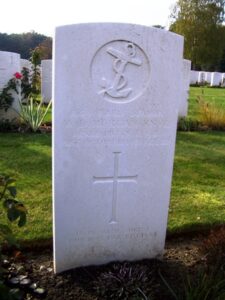
John Nicholas, Private, 14937, Kings Shropshire Light Infantry. John was the son of Mrs. Elizabeth Nicholas, of Glanavon, Cilgerran. He enlisted at Tonypandy into the Army, and was posted to the 7th Battalion, Kings Shropshire Light Infantry, which formed part of 76 Brigade. The Brigade moved to France during September 1915 and joined the 3rd Division near Ypres. In 1916 the division fought at the Actions of the Bluff, and at the St Eloi Craters. They were then moved south to the Somme, where they were to take part in the great Battle of the Somme, and fought there at the Battle of Albert, and at the Battle of Bazentin, where they captured Longueval. They then took part in the Battle of Delville Wood, and the Battle of the Ancre, before settling into another bleak winter in France. In May 1917 the Division were at Arras, and fought at the First and Second Battles of the Scarpe, and at the Battle of Arleux and the Third Battle of the Scarpe, where they captured Roeux. John was killed in action at Arras on 5 May 1917. He was 26 years old, and is commemorated on the Arras Memorial, France.
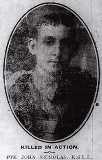

Evan Thomas Phillips, Private, 260483, Gloucestershire Regiment. Evan was the son of Rees and Mary Phillips, of Church Street, Cilgerran. He enlisted at Newport, Monmouth into the Monmouthshire Regiment, but was later transferred to the 12th Battalion, Gloucester Regiment, which formed part of 95 Brigade, 32nd Division. At the end of December, 1915 the Division was in France, and the following year took part in the opening of the Somme Offensive, fighting at the Battle of Albert, the Battle of Bazentin, the Battle of the Ancre and the resulting Operations on the Ancre. They remained here over the winter, and in March, 1917 followed the German Retreat to the Hindenburg Line. The division was near Ypres later in 1917, which is where Evan was taken ill and died on 5 October 1917. He was 31 years old, and is buried at Bedford House Cemetery, Belgium.
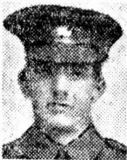
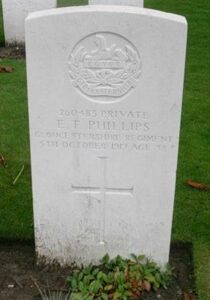
Thomas Rafferty, Private, 57759, Cheshire Regiment. Thomas was born at Cilgerran, the son of Patrick and Catherine Rafferty, and prior to the war lived at Llangennech. He enlisted at Cardiff into the Army and was posted to the Liverpool Regiment. Thomas was possibly not physically up to service in the front, and so he was posted to the 20th Battalion, Labour Corps, which formed part of the 60th Labour Company in France. Thomas took ill during the winter of 1916/1917 and was sent to the Base Hospital at Rouen for treatment, but he sadly died there on 26 January 1917. He is buried at St. Sever Cemetery Extension, Rouen, alongside 8,345 other soldiers who died there. Thomas is not commemorated at Cilgerran.
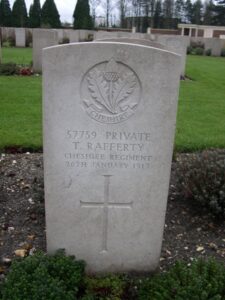
George Barley Rose, Sergeant, 12338, Welsh Regiment. George was born at Birmingham, and enlisted at Cardiff into the 2nd Battalion, Welsh Regiment. The Battalion was attached to the 1st Division, and moved to France at the outbreak of war, taking part in the retreat from Mons to the Marne, where the German offensive was held. The 2nd Welsh then moved to Ypres, where it helped stem the German push to the Channel ports, but suffered heavy casualties in desperate fighting. George joined the 2nd Welsh at Ypres on 29 November 1914. George was soon promoted to Sergeant, but was killed on 5 May 1915 during the Battle of Aubers Ridge. He is commemorated on the Addenda Panel of the Le Touret Memorial, France, which shows that his name was not on the initial casualty list when the memorial was made, but was added later.
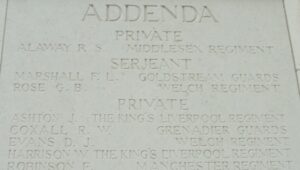
William Thomas, Private, 48948, Royal Army Medical Corps. William was born at Cilgerran, the son of David and Margaret Thomas. He spent four years as a pupil teacher at Cilgerran school before going on to Cardigan Intermediate School and then spent a period at Carmarthen Training College. After qualifying as a teacher he was appointed headmaster at Henry’s Moat School in Pembrokeshire. Having worked there for eighteen months he was promoted to headmaster of Llanddewi Velfry School, where he spent five years before enlisting at the end of 1915. He was posted to F Company, Royal Army Medical Corps, which was a training company based at Redan Hill, Aldershot. He married Daisy Victoria Thomas, a fellow teacher, from Narberth on 1 January 1916. Not much is known of William’s time at war, but he returned home to Narberth on 11 March 1916 suffering from ill health, and sadly died at home of sickness on 22 March 1916, aged 27. William is buried at Narberth Cemetery. His widow Daisy married William Griffiths Mathias after the war. Their only son, Flying Officer John Edward Mathias, DFC, was killed on 27 April 1944. The photograph of William and Daisy is courtesy of Michael Cullen.

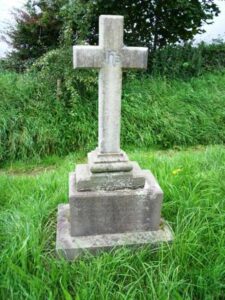
William Watts, Private, 46507, Welsh Regiment. William was born at Cilgerran. He had married prior to the war, and lived with his wife Alice M. Watts, at 28, Danygraig Terrace, Ynyshir, Glamorgan. William enlisted at Porth into the Army, and joined the 14th Battalion of the Welsh Regiment, known as the ‘Swansea Pals’, which formed part of 114 Brigade, 38th (Welsh) Division. The division crossed to France at the beginning of December 1915, taking up positions near Fleurbaix. They remained here for the next six months, before marching south to the Somme, where they took part in the famous attack on Mametz Wood during July 1916. After suffering heavy casualties, the division moved to positions north of Ypres, where they were to remain for the next twelve months. William was killed here just after the Battle of the Pilckem Ridge, on 5 August 1917. He was 41 years old, and is buried at New Irish Farm Cemetery, Belgium.
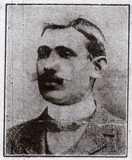
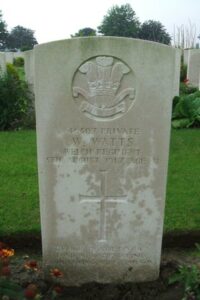
William Thomas Williams, First Mate, Mercantile Marine. William was the son of John Andrew and Anne Williams, of Cardigan. Prior to the war he lived with his wife Eleanor Williams at Ivy Cottage, Penybryn, Cilgerran. William served in the Mercantile Marine aboard the S.S. Treveal, a St. Ives registered cargo steamer. On 4 February 1918 Treveal was on voyage from Algiers to Barrow with a cargo of iron ore, when she was torpedoed and sunk off Anglesey by the German submarine U-53, with the loss of 33 lives. William was 49 years old when he died, and is commemorated on the Tower Hill Memorial, London. William is not commemorated at Cilgerran.
World War Two, 1939-1945
William Glyndwr Evans, Able Seaman, D/J 110359, Royal Navy. Glyn was the son of Henry Harries Evans and Hannah Eva Evans, and the husband of Hannah Mary Evans, of Cilgerran. He served in the Royal Navy aboard HMS Scarborough, which was a Hastings class sloop, which had been launched in 1930. She saw active service during the Second World War, especially as a convoy escort in the North Atlantic. She survived the war, but William died aboard Scarborough on 4 June 1942. He was 42 years old, and is commemorated on Panel 65 of the Plymouth Naval Memorial, Devon.
Desmond De Courcy Creagh Gower, Pilot Officer, 40905, Royal Air Force. Desmond was born on 7 December 1919, the son of E. W. Gower and Violet F. Gower of Castell Malgwyn, and before the outbreak of the Second World War was a pupil at the Imperial Service College, Haileybury. He entered the RAF, becoming a Pilot Officer in 253 Squadron, RAF. On 30 October 1939, No 253 Squadron reformed at Manston and was originally intended as a shipping protection unit with Blenheims. None were delivered, however, and the squadron began to receive Hurricanes in February 1940, becoming operational on 3 April. In May 1940 one flight was sent to France to reinforce the hard-pressed Hurricane squadrons while the second flight flew daily to French airfields from 17 to 23 May. Sadly Desmond was killed over France on 21 May 1940. He was just 20 years old, and is buried at Étaples Military Cemetery, France.
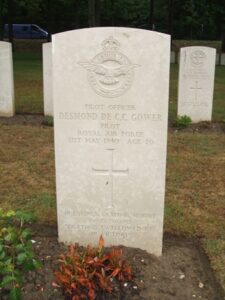
Sydney Griffiths, Volunteer, Home Guard. Sydney was the son of Jeremiah and Sarah Griffiths, and the husband of Sarah Elizabeth Mary Griffiths, of Cilgerran. He had served during the Great War, and in World War Two volunteered for service again, with the 1st Pembrokeshire (Tenby) Battalion, Home Guard. Sydney died on active service on 27 December 1940. He was 45 years old, and is buried at Llechryd (Llwynadda) Calvinistic Methodist Chapelyard. Sydney is not commemorated on the Cilgerran War Memorial.
Jacob Aneurin Hughes, Ordinary Seaman, Merchant Navy. Jacob was the son of David Hughes and Lily Hughes (nee Sambrook). He served in the Merchant Navy aboard the MV San Emiliano, a London registered Motor Tanker, built in 1939 by Harland & Wolff Ltd, Govan. On 9 August 1942 she was torpedoed by German submarine U-155 when 450 miles from Trinidad with the loss of 39 of the crew, en route from Curacoa for Trinidad and Table Bay and Suez carrying a cargo of 11,286 tons of aviation spirit. Jacob was just 19 years old, and is commemorated on the Tower Hill Memorial, London.
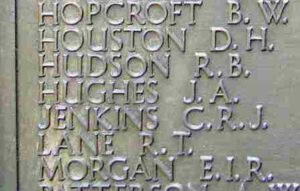
David Thomas Jones (Dewi), Lance Corporal, 3976184, The Welch Regiment. David was the son of Thomas Griffith Jones and Frances Ann Jones, of Cilgerran. Sadly David’s father Thomas was killed in action at Suvla Bay while serving with the Welsh Regiment at Gallipoli, on 11 August 1915. David followed in his father’s footsteps, joining the Welch Regiment, and he was posted to the 1/5th Battalion, which formed part of the 53rd (Welsh) Division, the same division that his father served in. The division landed in Normandy at the end of July 1944 as part of the reinforcing troops, and after a tough battle to break out of the Normandy beachhead, quickly began their drive North through France into Belgium. On 12 September Allied forces entered occupied Holland, and by 22 September the 53rd Division was involved in heavy fighting around Netersel, which is where David was killed during a German counter-attack on 24 September 1944. He was 30 years old, and is commemorated on the Groesbeek Memorial, Netherlands.
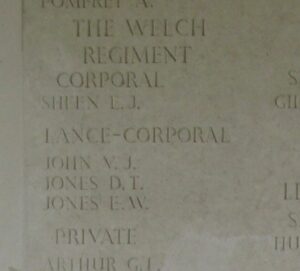
Oliver James Jones, Second Officer, Merchant Navy. Oliver was born in Abercych in 1905, the son of John and Hannah Jones. He married Irene Constance Livingstone Griffiths, of Angel House, Cilgerran in 1938 and the couple set up home at Lluest, Cilgerran. Oliver was a long serving Mariner and by the time war erupted was serving in the Merchant Navy as Second Officer aboard the tanker M.V. Frederick S. Fales. During September 1940, she joined Convoy HX72, which comprised of 42 ships, carrying materials to the United States. On the night of 21 September 1940, the convoy was spotted and attacked by the a Wolf Pack of five German U-Boats, led by Germany’s most famous submariner, Gunther Prien, the man who had so audaciously crept into Scapa Flow to sink the Battleship Royal Oak in 1939. After several losses among its fleet, the Germans withdrew, but the convoy was again hit in the early hours of 22 September 1940. In the darkness the submarine U-100 fired a salvo of torpedoes at the Frederick S. Fales, which exploded and sank some 340 miles west of Bloody Foreland with the loss of 20 men of her crew of 48. Among those killed was Oliver. The 35-year-old has no known grave but the sea, so is commemorated on the Tower Hill Memorial, London. This had been the first use of the Wolf Pack technique on a British Convoy, and it had been proved successful, with ten ships lost and a further three damaged over the two days.
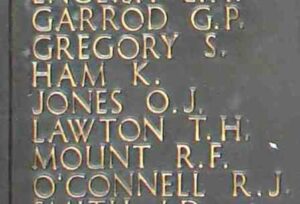
William Lewis. Cannot presently be identified.
William David Evans Parry, Private, 1493340, Pioneer Corps. William was the son of David and Lilly Parry, of Castle House, Cilgerran. He was serving as a Private with the Pioneer Corps when he died after the end of the war, on 11 November 1945, aged 27. Sadly very little is presently known of him, but he is buried at St. Llawddog Churchyard, Cilgerran. His brother-in-law, Dewi Stephens, was killed at sea.
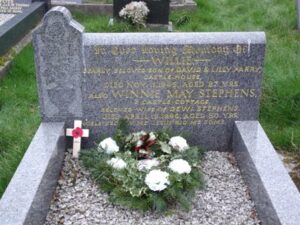
Andrew Kenneth Paton, Sapper, 2090209, Royal Engineers. Ken was the son of Kenneth Rome Paton and Olive Gertrude Paton, of Bristol. He served with 227 Field Park Company, Royal Engineers. The Company was in France at the outbreak of war, attached to the 48th Division of the BEF. It took part in the retreat to Dunkirk, and was involved in the blowing up of bridges, to slow the German advance. Ken was evacuated from Dunkirk in 1940, but died on active service in Britain on 15 January 1943. He was 20 years old, and is buried at Lincoln (Newport) Cemetery, England.
David Thomas Stephens, (Dewi), Third Engineer Officer, Merchant Navy. Dewi was the Husband of Winnie Stephens, of Cilgerran, and the brother-in-law of Will Parry. He served as Third Engineer Officer aboard the SS Pacific, a Hull registered vessel. Pacific had been built in 1923 for Sir W.H. Cockerline. The British cargo ship Pacific left Sunderland on 7 February 1943, in convoy for London carrying a cargo of coal. The convoy became scattered in bad weather during the night of 8 February, and at daybreak the following day, 9 February 1918 the Pacific and two other ships had disappeared. She carried a crew of 38, only one of whom was rescued. Dewi was 31 years old when he lost his life that night. He has no known grave, and is commemorated on the Tower Hill Memorial, London.
